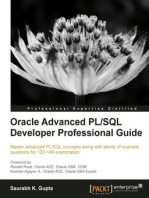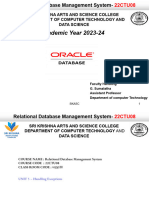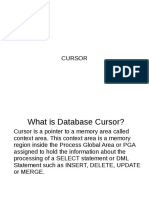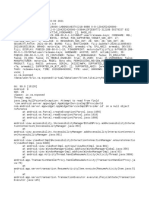0 ratings0% found this document useful (0 votes)
43 viewsHandling Exceptions: Part F
Handling Exceptions: Part F
Uploaded by
Deepak MalusareThe document discusses handling exceptions in PL/SQL. It defines an exception as an identifier that is raised during execution, either due to an Oracle error or being explicitly raised. Exceptions can be trapped using an exception handler within a block. The document covers predefined Oracle exceptions, trapping both predefined and non-predefined exceptions, and defining and raising user-defined exceptions. It provides examples of exception handling syntax.
Copyright:
© All Rights Reserved
Available Formats
Download as PPT, PDF, TXT or read online from Scribd
Handling Exceptions: Part F
Handling Exceptions: Part F
Uploaded by
Deepak Malusare0 ratings0% found this document useful (0 votes)
43 views18 pagesThe document discusses handling exceptions in PL/SQL. It defines an exception as an identifier that is raised during execution, either due to an Oracle error or being explicitly raised. Exceptions can be trapped using an exception handler within a block. The document covers predefined Oracle exceptions, trapping both predefined and non-predefined exceptions, and defining and raising user-defined exceptions. It provides examples of exception handling syntax.
Original Description:
SQL session 4F
Original Title
Session 4f
Copyright
© © All Rights Reserved
Available Formats
PPT, PDF, TXT or read online from Scribd
Share this document
Did you find this document useful?
Is this content inappropriate?
The document discusses handling exceptions in PL/SQL. It defines an exception as an identifier that is raised during execution, either due to an Oracle error or being explicitly raised. Exceptions can be trapped using an exception handler within a block. The document covers predefined Oracle exceptions, trapping both predefined and non-predefined exceptions, and defining and raising user-defined exceptions. It provides examples of exception handling syntax.
Copyright:
© All Rights Reserved
Available Formats
Download as PPT, PDF, TXT or read online from Scribd
Download as ppt, pdf, or txt
0 ratings0% found this document useful (0 votes)
43 views18 pagesHandling Exceptions: Part F
Handling Exceptions: Part F
Uploaded by
Deepak MalusareThe document discusses handling exceptions in PL/SQL. It defines an exception as an identifier that is raised during execution, either due to an Oracle error or being explicitly raised. Exceptions can be trapped using an exception handler within a block. The document covers predefined Oracle exceptions, trapping both predefined and non-predefined exceptions, and defining and raising user-defined exceptions. It provides examples of exception handling syntax.
Copyright:
© All Rights Reserved
Available Formats
Download as PPT, PDF, TXT or read online from Scribd
Download as ppt, pdf, or txt
You are on page 1of 18
Handling Exceptions
Part F
By: Deepak Malusare 1
Handling Exceptions with
PL/SQL
What is an exception?
Identifier in PL/SQL that is raised during execution
How is it raised?
An Oracle error occurs.
For example, if the error ORA-01403 occurs when no rows are
retrieved from the database in a SELECT statement, then
PL/SQL raises the exception NO_DATA_FOUND.
You raise it explicitly.
The exception being raised may be either user defined or
predefined.
How do you handle it?
Trap it with a handler.
By: Deepak Malusare 2
Handling Exceptions
Trap the exception If the exception is raised
DECLARE in the executable section
of the block and there is
BEGIN no corresponding
Exception
is raised exception handler, the
EXCEPTION
PL/SQL block
Exception
is trapped END; terminates with failure
and the exception is
propagated to the calling
environment.
By: Deepak Malusare 3
Exception Types
Predefined Oracle Server
Non-predefined Oracle Server }
Implicitly
raised
User-defined Explicitly raised
By: Deepak Malusare 4
Predefined Exceptions
Most common errors that occur in programs
PL/SQL language:
Assigns exception name
Provides built-in exception handler for each
predefined exception
System automatically displays error message
informing user of nature of problem
Can create exception handlers to display
alternate error messages
By: Deepak Malusare 5
Trapping Exceptions
Syntax
EXCEPTION
WHEN exception1 [OR exception2 . . .] THEN
statement1;
statement2;
. . .
[WHEN exception3 [OR exception4 . . .] THEN
statement1;
statement2;
. . .]
[WHEN OTHERS THEN
statement1;
statement2;
. . .]
By: Deepak Malusare 6
Trapping Exceptions Guidelines
WHEN OTHERS is the last clause.
EXCEPTION keyword starts exception-
handling section.
Several exception handlers are allowed.
Only one handler is processed before leaving
the block.
You can have at most one OTHERS clause.
Exceptions cannot appear in assignment
statements or SQL statements.
By: Deepak Malusare 7
Trapping Predefined
Oracle Server Errors
Common errors that have been given predefined
names
Reference the standard name in the exception-
handling routine.
Sample predefined exceptions:
Error Code Exception Name Description
ORA-00001 DUP_VAL_ON_INDEX Unique constraint violated
ORA-01001 INVALID_CURSOR Illegal cursor operation
ORA-01403 NO_DATA_FOUND Query returns no records
ORA-01422 TOO_MANY_ROWS Query returns more rows than expected
ORA-01476 ZERO_DIVIDE Division by zero
ORA-01722 INVALID_NUMBER Invalid numeric conversion
ORA-06502 VALUE_ERROR Error in arithmetic or numeric function operation
By: Deepak Malusare 8
Predefined Exception
Syntax
BEGIN
EXCEPTION
WHEN NO_DATA_FOUND THEN
statement1;
statement2;
WHEN TOO_MANY_ROWS THEN
statement1;
WHEN OTHERS THEN
statement1;
statement2;
statement3;
END;
By: Deepak Malusare 9
Undefined Exceptions
Less common errors
Do not have predefined names
Must explicitly declare exception in program’s
declaration section
Associate new exception with specific Oracle
error code
Create exception handler in exception section
Using same syntax as for predefined exceptions
By: Deepak Malusare 10
Trapping Non-Predefined Oracle
Server Errors
Less-common errors that have not been given
predefined names
Declare Associate Reference
Declarative section Exception-handling
section
• Name the • Code the PRAGMA • Handle the
exception EXCEPTION_INIT raised
exception
By: Deepak Malusare 11
Non-Predefined Error
Trap for Oracle Server error number
–2292, an integrity constraint violation.
DECLARE
e_emps_remaining EXCEPTION;
e_emps_remaining EXCEPTION; 1
PRAGMA
PRAGMA EXCEPTION_INIT
EXCEPTION_INIT ((
e_emps_remaining,-2292);
e_emps_remaining, -2292); 2
v_deptno dept.deptno%TYPE := &p_deptno;
BEGIN
DELETE FROM dept
WHERE deptno = v_deptno;
COMMIT;
EXCEPTION
WHEN e_emps_remaining THEN 3
DBMS_OUTPUT.PUT_LINE ('Cannot remove dept ' ||
TO_CHAR(v_deptno) || '. Employees exist. ');
END;
By: Deepak Malusare 12
Functions for Trapping
Exceptions
SQLCODE
Returns the numeric value for the error code
SQLERRM
Returns the message associated with the error
number
By: Deepak Malusare 13
Functions for Trapping
Example
DECLARE
Exceptions
v_error_code NUMBER;
v_error_message VARCHAR2(255);
BEGIN
...
EXCEPTION
...
WHEN OTHERS THEN
ROLLBACK;
v_error_code := SQLCODE ;
v_error_message := SQLERRM ;
INSERT INTO errors
VALUES(v_error_code, v_error_message);
END;
By: Deepak Malusare 14
User-defined Exceptions
Do not raise Oracle runtime error
Require exception handling to
Enforce business rules
Ensure integrity of database
By: Deepak Malusare 15
Trapping User-Defined
Exceptions
Declare Raise Reference
Declarative Executable Exception-handling
section section section
• Name the • Explicitly raise • Handle the
exception the exception by raised
using the RAISE exception
statement
By: Deepak Malusare 16
User-Defined Exception
Example
DECLARE
EXCEPTION;
e_invalid_product EXCEPTION; 1
BEGIN
UPDATE product
SET descrip = '&product_description'
WHERE prodid = &product_number;
IF SQL%NOTFOUND THEN
RAISE e_invalid_product; 2
END IF;
COMMIT;
EXCEPTION
WHEN e_invalid_product
e_invalid_product THEN 3
DBMS_OUTPUT.PUT_LINE('Invalid product number.');
END;
By: Deepak Malusare 17
General Syntax for Declaring,
Raising, and Handling a User-
defined Exception
By: Deepak Malusare 18
You might also like
- Oracle Database Administration Interview Questions You'll Most Likely Be Asked: Job Interview Questions SeriesFrom EverandOracle Database Administration Interview Questions You'll Most Likely Be Asked: Job Interview Questions SeriesRating: 5 out of 5 stars5/5 (1)
- Functional Specification Document TemplateDocument10 pagesFunctional Specification Document TemplateSamplet BackupNo ratings yet
- Exceptions - PPT 0Document18 pagesExceptions - PPT 0Praveen JoshiNo ratings yet
- Oracle Advanced PL/SQL Developer Professional GuideFrom EverandOracle Advanced PL/SQL Developer Professional GuideRating: 4 out of 5 stars4/5 (8)
- Oracle Database Security Interview Questions, Answers, and Explanations: Oracle Database Security Certification ReviewFrom EverandOracle Database Security Interview Questions, Answers, and Explanations: Oracle Database Security Certification ReviewNo ratings yet
- OIC Sample QuestionsDocument3 pagesOIC Sample QuestionssusomNo ratings yet
- Diomidis Spinellis - Code Reading - The Open Source Perspective. v. 1-Addison-Wesley Professional (2003) PDFDocument505 pagesDiomidis Spinellis - Code Reading - The Open Source Perspective. v. 1-Addison-Wesley Professional (2003) PDFSwati C100% (1)
- Handling Exceptions With PL/SQLDocument17 pagesHandling Exceptions With PL/SQLEdimarf SatumboNo ratings yet
- PLLes 08Document28 pagesPLLes 08Abhisek DasNo ratings yet
- Error Handling: Any Well-Written Program Must Have The Capability To Handle ErrorsDocument12 pagesError Handling: Any Well-Written Program Must Have The Capability To Handle Errorssankarji_kmuNo ratings yet
- PLSQL Eception HandlingDocument19 pagesPLSQL Eception Handlingumang kumarNo ratings yet
- 4exception HandlingDocument12 pages4exception HandlingLohith SeedellaNo ratings yet
- PLSQL 7 1 SGDocument31 pagesPLSQL 7 1 SGSenthilkumar MuthusamyNo ratings yet
- Section 7 QuizDocument6 pagesSection 7 Quizsyahndra100% (1)
- Lesson 8Document19 pagesLesson 8afrahabdirahman80No ratings yet
- Section 7 Lesson 1Document10 pagesSection 7 Lesson 1Madalina MV100% (2)
- Exp. No. 7Document12 pagesExp. No. 79047007778No ratings yet
- Exception Handling: Oracle Short Term Course TIETDocument63 pagesException Handling: Oracle Short Term Course TIETeumine100% (1)
- Exception Handling Exception Handling Exception Handling Exception HandlingDocument13 pagesException Handling Exception Handling Exception Handling Exception HandlingshailuramNo ratings yet
- Les08 12787960256376 Phpapp01Document22 pagesLes08 12787960256376 Phpapp01Mário AraújoNo ratings yet
- Section 7 QuizDocument6 pagesSection 7 Quizdaemon29No ratings yet
- Interview Question 26aug2017Document8 pagesInterview Question 26aug2017Ranitha NairNo ratings yet
- ExceptionDocument26 pagesExceptionajithram275No ratings yet
- PLSQL 7 1 SGDocument27 pagesPLSQL 7 1 SGPaulina CastrooNo ratings yet
- Explicit CursorsDocument6 pagesExplicit Cursorsnamithaa kNo ratings yet
- Unit-3 ExceptionsDocument12 pagesUnit-3 ExceptionsdemodgdgNo ratings yet
- Exception HandlingDocument9 pagesException HandlingRam KrishnaNo ratings yet
- Dbms Exp 4 TheoryDocument8 pagesDbms Exp 4 Theoryadijadhav104No ratings yet
- Chapter-5 PLSQL Programming Basics TutoriaDocument23 pagesChapter-5 PLSQL Programming Basics Tutoriaamit guptaNo ratings yet
- PLSQL 7 2 PracticeDocument4 pagesPLSQL 7 2 PracticeIka AgustinaNo ratings yet
- PLSQL For Beginners - Training GuideDocument176 pagesPLSQL For Beginners - Training Guideapi-3715433100% (1)
- SQL Unit5Document35 pagesSQL Unit5girab87633No ratings yet
- Study of Relational Database Management Systems Through OraclePL SQLDocument54 pagesStudy of Relational Database Management Systems Through OraclePL SQLUmashankar MishraNo ratings yet
- PLSQLDocument58 pagesPLSQLrambabudugyaniNo ratings yet
- Exception Handling in Java ProgrammingDocument19 pagesException Handling in Java ProgrammingKarthik KartNo ratings yet
- Final Exam Semester 1Document21 pagesFinal Exam Semester 1Alexandra PaparuscaNo ratings yet
- Unit V - Exception HandlingDocument25 pagesUnit V - Exception Handlingfictionlight30No ratings yet
- Oracle ExceptionsDocument12 pagesOracle ExceptionseverdanrajNo ratings yet
- Exceptions in OracleDocument5 pagesExceptions in OracleMainak DeNo ratings yet
- PLSQL 7 3 SGDocument25 pagesPLSQL 7 3 SGSenthilkumar MuthusamyNo ratings yet
- ORACLE PL/SQL Interview Questions You'll Most Likely Be AskedFrom EverandORACLE PL/SQL Interview Questions You'll Most Likely Be AskedRating: 5 out of 5 stars5/5 (1)
- OCA Oracle Database 11g Administration I Exam Guide (Exam 1Z0-052)From EverandOCA Oracle Database 11g Administration I Exam Guide (Exam 1Z0-052)No ratings yet
- Kotlin at a Glance: Use of Lambdas and higher-order functions to write more concise, clean, reusable, and simple codeFrom EverandKotlin at a Glance: Use of Lambdas and higher-order functions to write more concise, clean, reusable, and simple codeNo ratings yet
- The Java Workshop: Learn object-oriented programming and kickstart your career in software developmentFrom EverandThe Java Workshop: Learn object-oriented programming and kickstart your career in software developmentNo ratings yet
- Oracle Quick Guides: Part 4 - Oracle Administration: Security and PrivilegeFrom EverandOracle Quick Guides: Part 4 - Oracle Administration: Security and PrivilegeNo ratings yet
- Oracle SQL Revealed: Executing Business Logic in the Database EngineFrom EverandOracle SQL Revealed: Executing Business Logic in the Database EngineNo ratings yet
- The SQL Workshop: Learn to create, manipulate and secure data and manage relational databases with SQLFrom EverandThe SQL Workshop: Learn to create, manipulate and secure data and manage relational databases with SQLNo ratings yet
- Master Apache JMeter - From Load Testing to DevOps: Master performance testing with JMeterFrom EverandMaster Apache JMeter - From Load Testing to DevOps: Master performance testing with JMeterNo ratings yet
- The Resume Makeover: 50 Common Problems With Resumes and Cover Letters - and How to Fix Them: 50 Common Problems With Resumes and Cover Letters - and How to Fix ThemFrom EverandThe Resume Makeover: 50 Common Problems With Resumes and Cover Letters - and How to Fix Them: 50 Common Problems With Resumes and Cover Letters - and How to Fix ThemNo ratings yet
- Expert SQL Server Transactions and Locking: Concurrency Internals for SQL Server PractitionersFrom EverandExpert SQL Server Transactions and Locking: Concurrency Internals for SQL Server PractitionersNo ratings yet
- Advanced SAS Interview Questions You'll Most Likely Be AskedFrom EverandAdvanced SAS Interview Questions You'll Most Likely Be AskedNo ratings yet
- Session 5Document41 pagesSession 5Deepak MalusareNo ratings yet
- RCOS - Java: A Simulated Operating System With Animations: January 2001Document13 pagesRCOS - Java: A Simulated Operating System With Animations: January 2001Deepak MalusareNo ratings yet
- Enhanced Guide To Oracle: Using SQL Queries To Insert, Update, Delete, and View DataDocument51 pagesEnhanced Guide To Oracle: Using SQL Queries To Insert, Update, Delete, and View DataDeepak MalusareNo ratings yet
- Client/Server Databases and The Oracle 10g Relational DatabaseDocument26 pagesClient/Server Databases and The Oracle 10g Relational DatabaseDeepak MalusareNo ratings yet
- Advanced SQL and PL/SQL: Guide To Oracle 10gDocument22 pagesAdvanced SQL and PL/SQL: Guide To Oracle 10gDeepak MalusareNo ratings yet
- Enhanced Guide To Oracle 10g: Using SQL Queries To Insert, Update, Delete, and View DataDocument41 pagesEnhanced Guide To Oracle 10g: Using SQL Queries To Insert, Update, Delete, and View DataDeepak MalusareNo ratings yet
- Queries On Oracle HR - SchemaDocument7 pagesQueries On Oracle HR - SchemaDeepak MalusareNo ratings yet
- Advanced SQL and PL/SQL: Guide To Oracle 10gDocument22 pagesAdvanced SQL and PL/SQL: Guide To Oracle 10gDeepak MalusareNo ratings yet
- DDL, DML, ExcerciseDocument16 pagesDDL, DML, ExcerciseDeepak MalusareNo ratings yet
- CursorDocument39 pagesCursorDeepak MalusareNo ratings yet
- Types: Deptno Dname LOCDocument4 pagesTypes: Deptno Dname LOCDeepak MalusareNo ratings yet
- Constraints OdpDocument31 pagesConstraints OdpDeepak MalusareNo ratings yet
- More DDL CommandsDocument12 pagesMore DDL CommandsDeepak MalusareNo ratings yet
- 21a35a0113 Cohort 5Document26 pages21a35a0113 Cohort 5Noel MartinNo ratings yet
- SD-WAN General OverviewDocument22 pagesSD-WAN General OverviewYosia WijayantoNo ratings yet
- Security Issues Unit 2Document10 pagesSecurity Issues Unit 2Richa GargNo ratings yet
- SANGFOR - IAM - v12.0.42 - Best Practice - Activity Domain Script SSODocument44 pagesSANGFOR - IAM - v12.0.42 - Best Practice - Activity Domain Script SSOZM NashorNo ratings yet
- Introduction To Identity With Microsoft's CloudDocument7 pagesIntroduction To Identity With Microsoft's CloudHoang LeNo ratings yet
- QueueDocument1 pageQueueLinyi YiuanNo ratings yet
- Abusing SUDO (Linux Privilege Escalation)Document5 pagesAbusing SUDO (Linux Privilege Escalation)Aneudy Hernandez Peña100% (3)
- JasperReports Server Security GuideDocument92 pagesJasperReports Server Security GuideRafael Maiorali Agostino Leão ErenoNo ratings yet
- Examen Microsoft 70 697Document57 pagesExamen Microsoft 70 697Slim ABDELHEDINo ratings yet
- How To Change The Static Windows Boot Icon: What To Do BeforeDocument2 pagesHow To Change The Static Windows Boot Icon: What To Do BeforeTodd DevilleNo ratings yet
- CrashDocument15 pagesCrashVictorNo ratings yet
- Cache Fusion Oracle RacDocument25 pagesCache Fusion Oracle RacAgam GargNo ratings yet
- Dokumen - Tips - Sap Ewm Configuration Guide Visit of SCM Ewm A Step by Step Guide Which HasDocument5 pagesDokumen - Tips - Sap Ewm Configuration Guide Visit of SCM Ewm A Step by Step Guide Which Hasdipakdchaudhari0% (1)
- CPNI Compliance Statement 2017 PDFDocument1 pageCPNI Compliance Statement 2017 PDFFederal Communications Commission (FCC)No ratings yet
- Sapnote - 0000443500 - r3 Vs APO - Dates in Sales Orders and DeliveriesDocument3 pagesSapnote - 0000443500 - r3 Vs APO - Dates in Sales Orders and DeliveriesSantanu BoralNo ratings yet
- Senior Java DeveloperDocument3 pagesSenior Java DeveloperjuliobudiskiherculaniNo ratings yet
- Basic & Advanced SQL Interview Questions and AnswersDocument24 pagesBasic & Advanced SQL Interview Questions and AnswersPrabhakaran PeriyasamyNo ratings yet
- LogDocument3 pagesLogPandacode662 : ,No ratings yet
- Chapter 14Document9 pagesChapter 14Nhựt Tuấn HàNo ratings yet
- OOP Case StudyDocument8 pagesOOP Case StudyTrixie HipolitoNo ratings yet
- UML - Basic Notations: Class NotationDocument7 pagesUML - Basic Notations: Class Notationmayande rohiniNo ratings yet
- DBAM Solved.Document53 pagesDBAM Solved.aliabbas781064No ratings yet
- Ain Dumps 2022-Jul-04 by Mandel 220q VceDocument25 pagesAin Dumps 2022-Jul-04 by Mandel 220q VceDMANo ratings yet
- Simple Knowledge Organization System (SKOS) in 10 PointsDocument11 pagesSimple Knowledge Organization System (SKOS) in 10 PointsKaren Tinajero-VazquezNo ratings yet
- Chapter 07Document14 pagesChapter 07Kevin FarrisNo ratings yet
- Instructor Materials Chapter 1: Data and The Internet of ThingsDocument21 pagesInstructor Materials Chapter 1: Data and The Internet of Thingsabdulaziz doroNo ratings yet
- SSAD Assignment 5 Team ID 29Document7 pagesSSAD Assignment 5 Team ID 29Shivani JainNo ratings yet






































































































